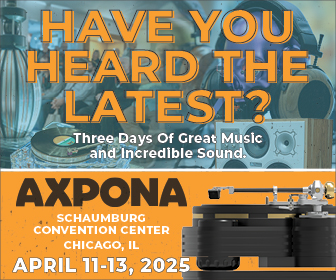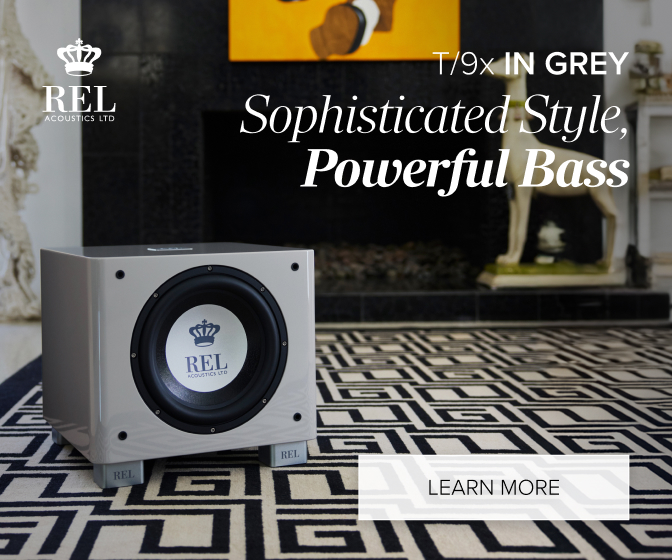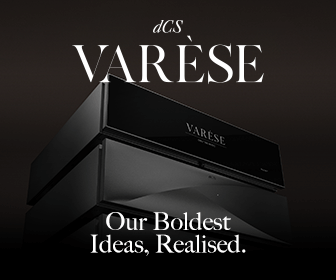Angela/Gilbert Yeung C312 Line Preamplifier
A sonically rewarding preamp with a few creative new twists.
“This one is gonna be fun,” I told myself when George Taylor of Entracte Audio emailed to inform me that an Angela/Gilbert Yeung C312 preamp was ready to ship. I met George and Angela/Gilbert at the 2023 Montreal Audiofest during my second exposure to the A/G gear. My favorable impressions led to me asking with alacrity to review something in the A/G line. I’m happy to report the C312 did not disappoint.
I’m a bit late to the Canadian party (rave?) for celebrating Angela/Gilbert’s achievement in realizing their fascinating concepts in creative executions of audio designs. Still, I’m glad I found the address.
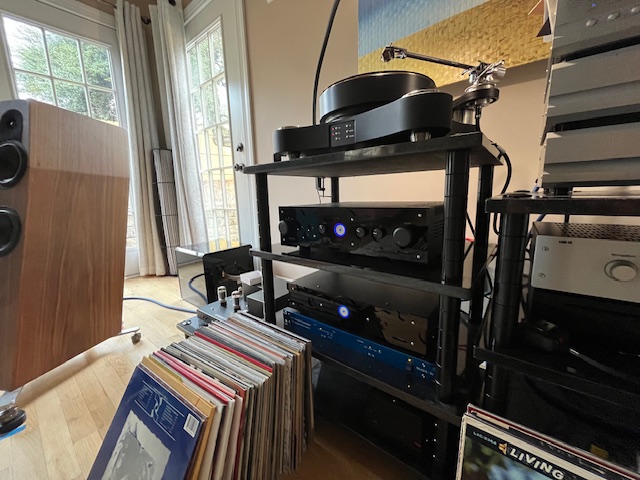 So What’s So Special About This Thing?
So What’s So Special About This Thing?
Plenty.
The C312 is visually striking, similar to the look of Mx. Yeung’s previous audio endeavor, Blue Circle Audio, yet it goes further into an artsy, bespoke appeal.
The metal chassis has a two-layer, tinted plexiglass front panel. When the unit is turned on, a silver disc in the center of the front panel lights up with a blue-green glow, imbuing the first layer of plexi with a faint purple glow. The second outer layer is an opaque black with a wave-like pattern on top and bottom cut away to expose the lower panel’s glow. I enjoyed the understated yet effective modern art look of the whole presentation.
Two large knobs on either side of the front panel are for balanced input selection, and on the right, volume. These have a nice rounded look with a luxurious knob feel. Next to the balanced input select are three toggle switches that mute or turn on the remaining three unbalanced inputs. Kinda weird, but no doubt there is a reason - possibly related to noise reduction. The remaining three front panel knobs are smaller and are labeled warm, tube s, and ss. More about these later.
 The connections for two balanced and three single-ended inputs on the rear panel are joined by a post-input selector and pre-volume control output (commonly known as a record out). Record-outs are a nice thing to have. I wish more preamps included this.
The connections for two balanced and three single-ended inputs on the rear panel are joined by a post-input selector and pre-volume control output (commonly known as a record out). Record-outs are a nice thing to have. I wish more preamps included this.
Then, we have unbalanced or balanced main outputs, a 4 pin male XLR plug for the remote power supply, and two additional XLR connectors to add outboard capacitor banks. Angela/Gilbert is well-known for using extreme amounts of capacitance to smooth power supply ripple. A back panel ground-lift switch enables a user to find the quietest operation. I heard no buzzing or difference in noise floor in either position. A small, keychain-mounted remote for volume rounds things out.
After many weeks of operating, listening, and looking inside the chassis, I got the vibe that everything about the design and execution of the C312 is as simple as it can be without being simpler than it should be.
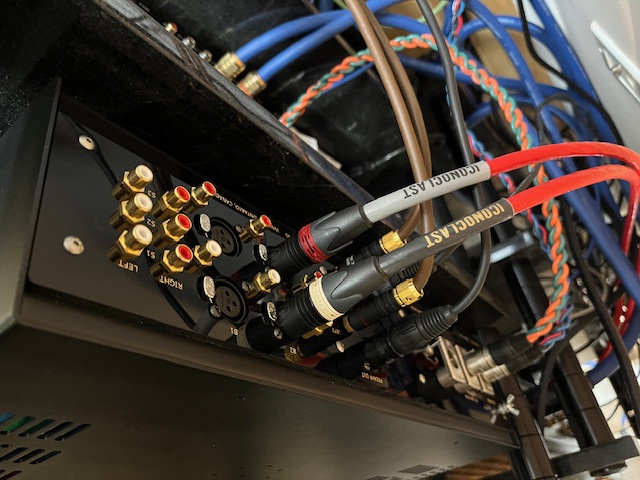 We Three Kings
We Three Kings
I love big knobs, I cannot lie, but on to those three smaller knobs I mentioned earlier.
My feeling is that besides the C312 being eerily quiet, clean sounding, and wide bandwidth, the “season to taste” knobs are really what this unit was all about.
The warm knob seems to contain the level of “drive” that feeds the tube s and ss knobs, which are used to blend between a tube simulation circuit and a more conventional solid-state path. Side note: the C318 preamp has actual vacuum tube circuits for its tube circuit path.
The warm knob affects the tube s side more colorfully but also changes the sonic feel of the ss side. When used with only the ss knob turned up, it seems to impart a change in damping that subjectively increases low end. When warm is used on the tube s side, higher harmonics are generated that start to be heard as increased detail and presence.
The combinations that can be arrived at using these three controls were daunting initially, but I implore folks who audition the C312 to be fearless. I realize that my audio mastering day job allows me the mindset to turn knobs and trust what I hear cause that’s what I do five days a week, but please, for the love of music, turn those knobs and trust your instincts!
During my setup process, I found that a minimal adjustment creates a very audible change in some (but not all) combinations. I also found that any increase of any knob will change the sound and make things louder, so it's essential also to use the large volume knob to compensate for the level increase (or decrease) when trying to evaluate a change accurately.
When using the seasoning knobs on the C312, a fair amount of the subjective amount of the bass and treble can be emphasized, yet the entire sense of coherence was never affected. One reason I can envision audiophiles' reticence to do a lot of exploring here is that even extreme settings sound cool! This lack of inner trust that most of us have can breed the neurotic question: what is the correct setting? I’ll give you a hint: there is no right setting. The question should be: What does your ear like? If this freaks you out, put all three knobs to 9 o’clock and forget they were ever there.
I wished for a remote that allowed me to adjust these parameters from the listening chain, but it wasn’t that big a deal to go back and forth while evaluating sonic changes.
I’ll say one more thing: these are not simple bass and treble controls in the sense of equalization. They are complex “vibe” controls that subjectively affect more than a subtle increase in bass and treble.
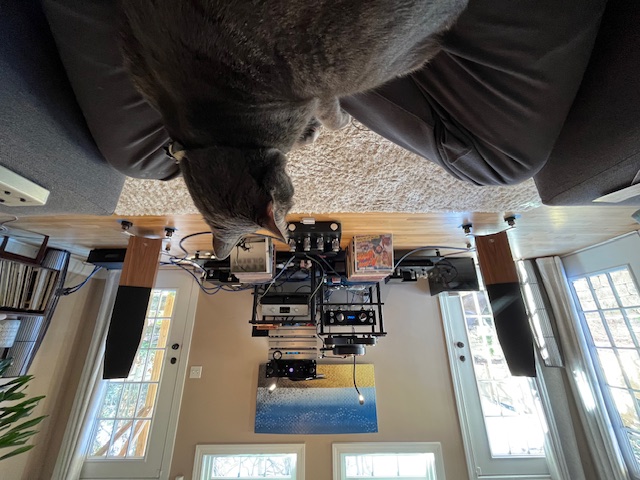 But What Does It Sound Like?
But What Does It Sound Like?
To go back in time for a minute, during my initial listen, the C312 sounded so different from what I’m used to hearing: it was disorienting. Seriously.
After a few hours of warm-up, there was an intriguing element to the sound, but it hadn’t fully gelled. The music sounded a bit flat and too polite in a weird way.
George had informed me this unit was fully broken in and only needed a half hour or so to warm up. Hmmm.
Later in the week, after a few sessions of playing with the knobs and finding a sweet spot that remained fixed for most of the audition period, I found myself with a day of no responsibilities, so let’s play rekkids!
Wow. I had an extreme reaction of bliss. Records had taken on an entirely new level of enjoyment. The preamp had significantly benefitted from being on for a couple of days. It was pretty dramatic compared to other gear I’ve used that didn’t seem to change much, if at all. After an hour or so of my brain swimming in dopamine, I tip-toed into analytical listening mode.
During my analytical listening sessions, two records in constant rotation were the half-speed, 45 RPM remaster of Peter Gabriel - Up and the latest Analog Productions 45 RPM remaster of Steely Dan - Aja. Both these records are favorites, and the high-quality sonics of these remasters only make ‘em better! Sure, I played a zillion other things, but these were my primary test subjects while I drilled down on the perceived use of the C312 seasoning knobs.
I set a baseline by first listening to my VAC Master Pre, then spent time with a Pass Labs XP-34 preamp that I’m reviewing.
Okay, in addition to scoring high in all the usual audiophile-approved sonic descriptors, one of the C312’s many unique talents was revealed to me at last: the portrayal of medium and small-scale dynamic changes in recordings was off the scale - and without any exaggeration of dynamics.
That things-always-percolating sound makes me nervous, and nothing of the like was ever heard. Yes, the flow of the music was entirely intact, in addition to every dynamic contrast. The C312 vibe was all about getting into my Zen of Musical Appreciation; the flow-with-life dynamic presentation was a big part.
I found imaging to have more sense of front-to-back than most other preamps I’ve heard. Sounds and instruments in the back seemed waaaay in the back with a simultaneous ability to put upfront information floating fixed in space, right in front of my listening chair. I can’t overemphasize how much I love when a component excels at this - and the C312 was killing it!
Our cat, Speedy, commonly sits in my lap as I listen. When “Sky Blue” off Up gets to the very end, just as the last piano chord starts to die out, a slight sound can be heard deep in the back of the soundstage. It’s probably a guitar player stepping on an effects pedal. Every time, Speedy awoke with a wide-eyed, menacing look, trying to locate the intruder in our house. Heh.
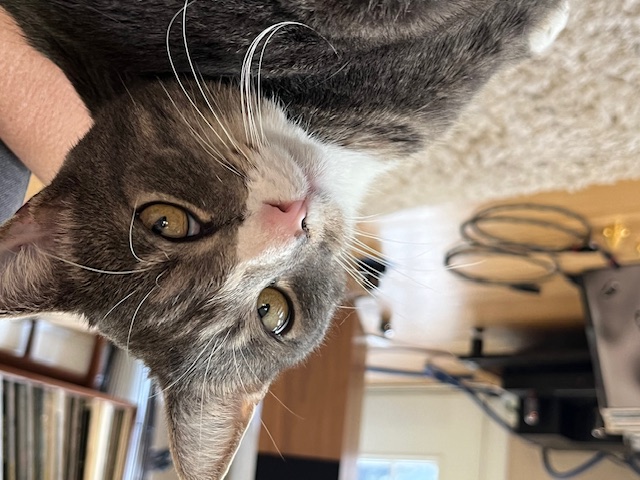 The image width was not entirely on par with the VAC Master Pre (or the Pass XP-32), but that’s not unusual. I heard very defined sounds from outside the speakers when playing a recording with Q Sound-like image placement using time and phase-related tricks in a mix. This kind of thing is all over Up cause nobody but Tchad Blake does it better. However, the width was solid, if not mind-blowing, in more typical recordings. With the Pass XP-32 in the system, there was more of an arc in front and behind the plane of speaker location, which connected to produce a spherical kind of thang. The C312 portrays more of an X/Y type of plot. Side note: the imaging changed considerably with the addition of an optional capacitor pack, which I’ll talk about in a bit.
The image width was not entirely on par with the VAC Master Pre (or the Pass XP-32), but that’s not unusual. I heard very defined sounds from outside the speakers when playing a recording with Q Sound-like image placement using time and phase-related tricks in a mix. This kind of thing is all over Up cause nobody but Tchad Blake does it better. However, the width was solid, if not mind-blowing, in more typical recordings. With the Pass XP-32 in the system, there was more of an arc in front and behind the plane of speaker location, which connected to produce a spherical kind of thang. The C312 portrays more of an X/Y type of plot. Side note: the imaging changed considerably with the addition of an optional capacitor pack, which I’ll talk about in a bit.
I found it difficult to hear anything amiss with the tonality in the critical midrange area of approximately 200hz up to the lower treble. I also found it challenging to assign any subjective descriptions to the frequency extremes partially because those are the areas I found most affected by the three seasoning knobs.
However, at almost any setting of the seasoning controls, transient leading edges were quick but friendly to my ear. In some more extreme settings, edges seemed more rounded or accentuated than may be optimal - given the other tonal and transient characteristics of a user’s system - but these extreme settings might be just what the doctor ordered.
Side one of Aja was perfect for letting me hear the sumptuous but not overbearing tonal signature of the C312. Fagan’s voice, sax solos, bass lines, and anything occurring in a broad region of midrange around 200hz-4K had a great sense of weight and density without sounding overly romantic.
This attribute of having clear and defined upper-midrange and treble transients that are simultaneously smooth and inviting is something I usually hear only in costly gear. For me, this is what makes a component sound refined and expensive. On my judges' scorecard, I’ll give the C312 a 9.5 in this category.
 More Listening Observations
More Listening Observations
I'm only going to describe a few more analytical experiences because, after a short time, I could barely force myself to listen analytically. If you know me, that may be the highest praise I can give any component.
All during my listening time, I consistently had a sense of a tremendous amount of added musicality due to whatever sonic fingerprints the C312 contributed. Late in my listening time with the C312, I needed to send the VAC back to Sarasota for a short winter vacation, so the Pass XP-32 was repeatedly very helpful in contrasting the C312’s living, breathing, and organic quality against the XP-32's cleaner, more elegant and grainless vibe.
I would be delighted with the XP-32 as my primary preamp reference; it sounds exceptional.
However, the music had a much bigger jump factor when the C312 was in the system. I heard some special sonic sauce (say that three times fast) in play when I spun vinyl favs. There was also the barest hint of a slight added edge to the upper midrange, but most times, it wasn’t enough to capture my attention - I had to listen hard to hear it. Maybe this was part of the special sauce?
The weight and slam of the C312’s low end manifested as almost a wave rolling in - very coherent, unified, and big and gnarly. Everything above was glued to this solid foundation. On the opposite end of the spectrum, I caught myself listening to what my ears were saying about high-frequency transient quality from things like vocal sibilance, drum kit cymbals, and stringed acoustic instruments. While not as squeaky clean and mission-critical sounding as the Pass pre, the C312’s hint of added texture up there was not unwelcome. For the most part, it was smooth, never glassy, but with an added bit of something that was audible - and likable.
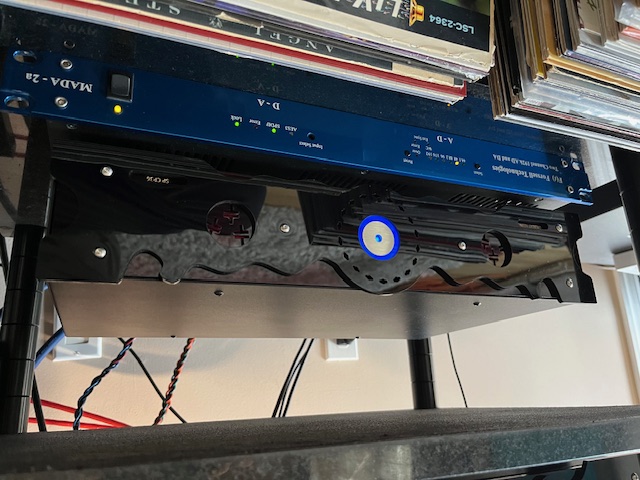 Prescript
Prescript
Wouldn’t ya know it? There was more to the story.
Late in the game, I asked George if he could send me an optional SP Capacitor Pack 36, designed by Angela/Gilbert Yeung, as a sonic upgrade. He was very kind to oblige. Thank you, George, and thank you, Angela/Gilbert.
The SP Cap Pack 36 adds 3.6 Farads to the 1.2 Farads included with the stock power supply for a whopping 4,800,000 microfarads!
Yowzers. I’ll simply say this is a must-have add-on. The tired audio review cliche of “everything was better” is embarrassingly appropriate here. The additional capacitor pack took about three days to employ its powers fully, but when everything kicked in, it was a thing of beauty that took the C312 from excellent sounding to trance-inducing.
I could easily hear how the chassis with extra capacitors supercharged the C312 imaging properties, especially width. Images also became more precisely located yet woven into a hemispherical arc of sound. The C312 was no longer a runner-up to the VAC and Pass in this department.
The extra cap box also bestowed more of a sense of flow and seamlessness to the music - but not at the expense of detail. The extremely slight edge I had occasionally heard was now gone.
Thinking about what could happen with a second additional cap box gave me strange dreams about the fabric of space-time. Whatever.
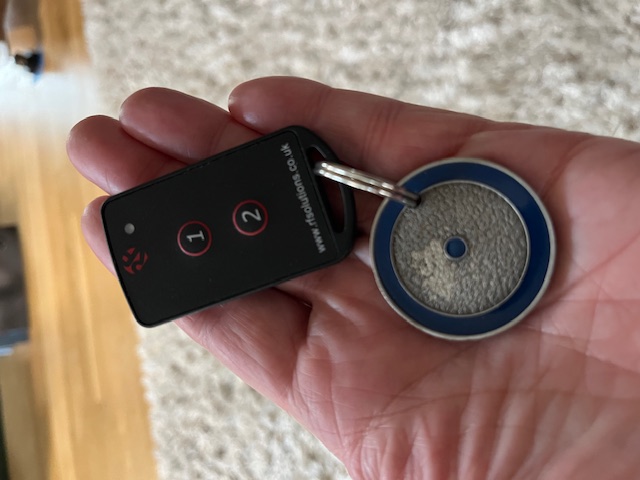 Wrap Up
Wrap Up
For an MRSP of $6,800 for the C312 and $3,000 for the SP Capacitor Pack 26 (auditioned here), Angela/Gilbert Yeung has created something quite remarkable - regardless of price.
The C312 will not appeal to every audiophile. It has no fancy features like an LCD screen or an overabundance of connectivity. For a minimalistic line preamp, I was psyched that it had a remote volume control!
For that group of listeners who can’t or don’t want to spend north of $20K for a line preamp yet want a highly refined sense of performance while retaining every particle of a recording’s musical intent, the C312 might be your perfect jam. It’s very high on my scale for sheer musicality and listenability; this is not meant to imply it lacks any resolution ability - far from it. If a sonic presentation that is all facts and no soul can be called dry, I’ll describe the C312 as a light drizzle in the morning, turning to sunshine by mid-day. And then you have the three season-to-taste knobs, which are the veritable icing on the cake.
There is more than enough detail, imaging fireworks, and dynamic performance to satisfy any listener - even hardcore audiophiles.
To those in the market (or just intrigued), I highly recommend putting ears on a C312. You can thank me later.
 Postscript
Postscript
I asked Angela/Gilbert some questions about their process. Here are the questions and answers:
1. It’s evident that your creativity as an audio designer and in other parts of your life inform your approach. Can you tell the readers about any a-ha moments in the design process of the C312 that are part of its sonic signature?
A-Ha moments don’t usually happen during the design process – they usually happen before. The C312 design has been a continuous process dating back to 2010, when I built a preamplifier called the BC307, which had adjustable 6SN7 and 6922 tube gain stages, and adjustable solid-state gain stages. A few years later I found a way to make solid-state circuits sound tube-like and began to produce them as passive outboard devices called Tube Simulators.
In 2018 I built a solid-state integrated amplifier called the NFS238. The NFS238 was built for my own listening enjoyment, and as an experiment to find out how well the tube simulator circuits would work in an adjustable format. As it turned out, they worked very well. After I started operations with the new Angela-Gilbert brand, George and I began discussing the possibility of building a preamplifier with adjustable Tube Simulator circuits built inside.
2. How did you hit on using what some would consider extreme amounts of power supply capacitance? Can you describe the subjective effects on the sound? Is there a point where the sound starts to suffer beyond a certain amount of capacitance?
As a designer-builder, one always experiments with different components and configurations. As time went by, I kept finding that the more attention I paid to the size and structure of power supplies, the better musical results I was achieving. Music is very much a “time-critical” phenomenon, so the ability to gather, store, and transfer energy quickly is of paramount importance. Increasing the capacitance in the power supply does not change the sound profile of a piece of equipment, but it does increase that piece of equipment’s ability greatly. By any audiophile metric that we have – dynamics, timbre, imaging, bass response and control, etc. – there will be an improvement, so the sound is most definitely better. To this point, we really haven’t found a limit on improvement, and there are no signs of any kind of negative effects.
3. How integral to your design objectives is parts selection? Circuit layout? Silicone damping? Are the different colors just for fun or is there a sonic correlation?
I don’t consider specific parts to be the most important aspect of my design objectives. Of course, I want good parts that perform consistently and reliably, but to me, it’s more about how the parts are used in conjunction with each other, and how well they are assembled. The overall “recipe” is far more important than the individual parts. Circuit layout is a consideration, but the circuit layout becomes obvious once the overall design objectives are established.
Silicone damping is not really a design goal, it’s more of a bonus. Silicone is used more for fastening than for damping. It does provide damping though, which I feel to be a good thing. As for the colours of the silicone, there are times when it is for fun, and other times when it is an indication of the purpose of a circuit. The coloured silicone is more often used on the open-concept prototype gear, and it can indicate the type of circuit, amounts of capacitance, where certain things are to be plugged in, and of course to make the gear more interesting to look at. When I use coloured silicone on a production product, it is most often because I need to use it as an adhesive, but will colour the silicone to match the inside of the component.
4. When a design meets the proper measurement-based criteria, what is your process for going deeper into subjective listening territory? If you look deeply into measurements, is there a particular measurement correlating to what you want to hear?
I measure every new design extensively. Because I complain a lot about buying equipment based on published measurements, I’m sure that many will assume that I don’t think that measurements are important. In fact, I do believe measurements are important because they indicate whether a piece of equipment is functioning properly in an electrical sense.
After a complete set of measurements are done, the listening process begins. I have several beta testers who give me feedback on how the new component is performing. I use that data to see if there is a pattern of sonic behaviour and then do another series of measurements to see if there is a correlation between the two. Sometimes there are indications, but nothing that absolutely relates measurement to sound. I just don’t believe that there is any way to “measure” sound quality.
5. When do you know a design is done? Is it ever really done?
Nothing is ever perfect, so no – a design is never really done. There is a point at which the stated design goals, the sonic performance, and the planned priced point of a production product meet an optimum balance. A model number is then finalized, and the new product becomes available for sale. After that, it is time to move on to the next new idea.
6. Do you have any particular reference music you like to use during your process? What do you listen for?
I don’t have any “reference music”. I try to listen to a variety of styles to make sure that I am getting characteristic and believable performances. I don’t believe that equipment should be designed around a single genre of music. When I listen to music, I listen for emotion and authenticity. I have come to realize that if I am paying attention to criteria like depth, soundstage, and imaging, then I am not paying attention to the music itself – which means that I am not engaged and therefore something is wrong.
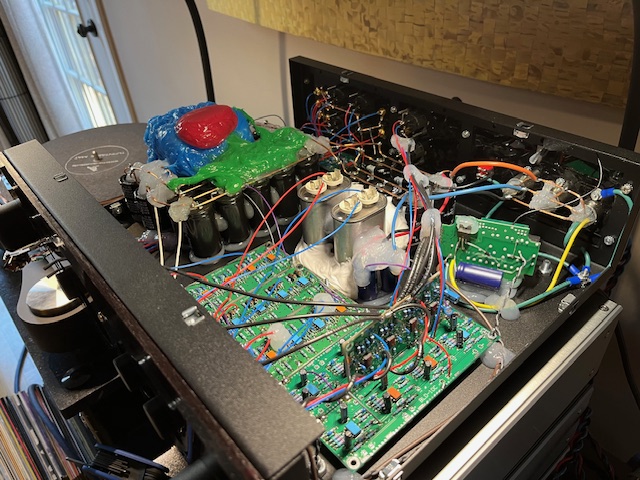
Specifications
Dimensions (Preamp) - 17”W x 5”H x 15.75”D (including volume control knob and rear panel jacks)
Weight (Preamp) – 26 lbs.
Dimensions (External Power Supply) – 4”H x 5”W x 9”D
Weight (External Power Supply) – 6lbs
Inputs – Two Balanced, three RCA
Preamp outputs – One Balanced, One RCA
Remote – volume only
Total power supply capacitance – 1.2 Farads (1,200,000 uF)
Input Impedance (balanced) - 57 K ohms
Input Impedance (unbalanced) - 52 K ohms
Output Impedance (balanced) - 4.1 ohms
Output Impedance (unbalanced) - 2.3 ohms
THD + N – 0.004%
Frequency response – flat within 0.5dB from 5Hz to 48kHz
Signal to noise ratio – 90dB (from 20Hz to 20kHz)




